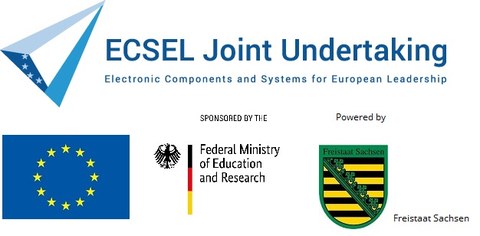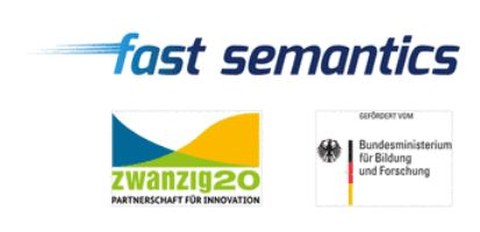Research Projects
Neuromorphic Computing Platform (SP9)
- SP9 designs, implements and operate a Neuromorphic Computing Platform. This Platform allows non-expert neuroscientists and engineers to perform experiments with configurable Neuromorphic Computing Systems (NCS), implementing simplified versions of brain models developed on the Brain Simulation Platform, and on generic circuit models.
Zeitraum: 1.10.2013 -31.3.2023
- Ramp-up: 1.10.2013 - 31.3.2016
- SGA1: 1.4.2016 - 31.3.2018
- SGA2: 1.4.2018 - 31.3.2020
- SGA3: 1.4.2020 - 31.3.2023
- weitere Informationen finden Sie hier
The "Spiking Neural Network Architecture" SpiNNaker describes a computer architecture, optimized for the simulation of neural networks. A large number of ARM processors are integrated in a system architecture optimized for communication and memory access. This enables energy-efficient simulation in biological real time, whereby SpiNNaker is clearly superior to current supercomputers in both aspects. The first generation of SpiNNaker was developed by the University of Manchester and scaled up to a system size of 1 million ARM processors. This allows real-time simulation of networks in the order of 1% of the human brain (with a latency down to 1 ms).
The aim of the SpiNNcloud project is to set up a SpiNNaker2 machine at the TU Dresden and, in addition to the classic use in brain simulation, to establish it in Saxony as 'SpiNNcloud' for research in the areas of tactile internet, Industry 4.0 and automotive artificial intelligence (AI) .
project runs from 23.09.2019 to 30.06.2022
ECSEL Joint Undertaking
„AI for New Devices ANd Technologies at the Edge (ANDANTE)“
sub-project: Memory-optimized learning for embedded systems
The ANDANTE project develops new methods and hardware for artificial neural networks in embedded systems.To do this, it spans a bridge from new components to embedded hardware to AI applications in the field of IoT. The goal is to increase efficiency compared to existing solutions in order to be able to implement more complex and powerful AI applications in embedded systems.
time period: 01.07.2020 - 30.06 2023
Exzellenzcluster “Centre for Tactile Internet with Human-in-the-Loop” (CeTI)
Nächste Stufe der Digitalisierung: Mensch und Maschine interagieren in Echtzeit
Das „Zentrum für taktiles Internet mit Mensch-Maschine-Interaktion“ der TU Dresden will die Zusammenarbeit zwischen Mensch und Maschine auf eine neue Stufe heben. Menschen sollen künftig in der Lage sein, in Echtzeit mit vernetzten automatisierten Systemen in der realen oder virtuellen Welt zu interagieren.
weitere Informationen finden Sie hier
Volltitel:
fast actuators, sensors and tranceivers, secure manufacturing real time systems)
Im Projekt fast semantics wird im Rahmen des fast actuators, sensors & tranceivers (fast) Clusters die Umsetzung eines hardwarebasierten OPC UA Servers untersucht, der als periphere Komponente für Mikrorechenarchitekturen. Die Implementierung des Server in Hardware ermöglicht erstmal die vollständig deterministische, hart-echtzeifähige Umsetzung des OPC UA Protokolls on-chip. Der für das Projekt entstehende ASIC verwendet zudem die 28nm CMOS SLP Technologie, die extreme energieeffizienz ermöglicht. Der durch das fast carnet beigesteuerte 2-Wire, GBit Ethernet PHY bietet eine echtzeitfähige Kommunikationsanbindung mit hoher Bandbreite. Es entsteht eine hochgradig parametrisierbare, skalierbare IP-Grundlage für semantisch kommunizierende Aktoren und Sensoren in der Feldebene.
Zeitraum: 01.01.2017 - 31.12.2019
weitere Informationen finden Sie hierhier
The aim of the KI-ASIC project is to develop intelligent, fully integrated sensor modules with neuromorphic AI accelerators for energy-minimal data preprocessing.
Neuromorphic information processing with low latency and high energy efficiency is to be tested using pattern recognition with radar sensors. Proven methods based on analog artificial neural networks as well as new network architectures based on pulsed neural networks are used for this. In KI-ASIC, the TU Dresden is dedicated to the implementation of neuromorphic signal processing on the neuromorphic multiprocessor platform SpiNNaker2. For this purpose, novel neuromorphic algorithms based on radar sensor data for predicting events are developed.
time period: 01.08.2019 - 31.07.2022
Low VOltage SchalTungstechniken für Ultra Low Power Mixed Signal Systeme
Teilthema: Analoge Frontends für Bio-Interface Chips
Die elektrophysiologische Erfassung von Nervenaktivität durch implantierte Elektrodenarrays hat schon heutzutage einen hohen Stellenwert in der klinischen Praxis. Hierbei handelt es sich allerdings weitestgehend um akute Anwendungen am offenen Hirn, welche es nicht erlauben, Langzeitstudien zu betreiben, oder sogar Signalklassifikationen zur Frühwarnung vor beispielsweise epileptischen Anfällen zu erreichen.
Der Schritt hin zu langzeitanwendbaren Systemen wird derzeit im Wesentlichen durch folgende Faktoren verhindert:
- Zum einen ist es anwendungsbedingt notwendig die Messkette nah an das Elektrodenarray zu bringen, um eine Einstreuung von Störsignalen zu vermeiden,
zum anderen bedeutet dies jedoch, dass die vom aktiven Implantat erzeugte Wärmedissipation in großer Nähe zu neuronalem Gewebe zu Komplikationen führen kann.
Um in dieser Situation die von den zuständigen Prüfstellen definierten Richtlinien zur Biokompatibilität von aktiven Implantaten einhalten zu können,
kommen zum aktuellen Stand der Technik nur Systeme mit begrenzter Anzahl an Kanälen oder geringer räumlicher- oder zeitlicher- Auflösung zum Einsatz.
Diese Systeme setzen sich im klassischen Fall aus mehreren Vorverstärker- und Treiberstufen zusammen,
welche vor der Signalerfassung durch ADCs dazu genutzt werden, das Signal zu filtern und den Signal-zu-Rausch-Abstand zu erhöhen.
In diesem Schritt ist es möglich die Anzahl der benötigten ADCs über analoge Multiplexer zu reduzieren und somit den Energiebedarf zu reduzieren.
- Gleichzeitig ist sind ein Großteil der Entwicklungen im Feld der Biosignalerfassung der letzten Jahre akademische Arbeiten, welche aufgrund ihres mangelnden Bezugs auf geltende Normen nur geringes Potenzial haben, Einzug in die klinische Praxis zu erlangen.
Der hier verfolgte Lösungsansatz beruht im Gegensatz zum klassischen Ansatz
auf einer weitestgehenden Digitalisierung der Messkette.
Hierbei werden Technologieeigenschaften der22nm FDSOI-Technologie ausgenutzt, um die vorgeschriebene maximale Wärmedissipation und das daraus resultierende geringe Energiebudget einzuhalten.
Insbesondere im Frontend-Design kann von der geringen Leckstromaufnahme (Adaptive Body Biasing), und der geringen Versorgungsspannung in 22nm Technologien profitiert werden.
Arbeitsziel ist es, basierend auf diesem Ansatz, die Grundlage für neuartige klinisch anwendbare Technologien zu schaffen.
Laufzeit: 01.08.2019 - 31.07.2021
-
Ziel des Projektvorhabens PRIME ist es eine offene Ultra-Low-Power-Plattform für IoT zu schaffen. Im Teilvorhaben „Energieeffiziente System-on-chip Plattformen für hochperformante Sensoranwendungen“ der TU Dresden ist geplant, einen MPSoC zu entwerfen, in 22nm FDSOI GLOBALFOUNDRIES- Technologie fertigen zu lassen sowie innovative Mixed-Signal IP Blöcke für effektives Energiemanagement zu entwickeln.
-
Zeitraum: 01.04.2016 - 30.09.2019
Scalable infrastructure for edge computing (Scale4Edge)
sub-project: AI / DSP accelerator IP for RISC-V
The development goal of the overall "Scale4Edge" project is a commercial ecosystem for a scalable and flexibly expandable edge computing platform. This system will be based on the free RISC-V instruction set architecture. The ecosystem covers all essential aspects such as low power, security, reliability, verification, testing, compilers, software libraries and debugging. It is supplemented by specification, verification plan and documentation. It therefore offers a scalable, individually adapted complete solution including support. This also includes standard-compliant design processes, partially open-source software and also the safety of the platform, as well as an intensive review and analysis of developments.
In the RISC-V ecosystem, the work in the sub-project of the TU Dresden focuses on the design and implementation of hardware accelerator IP for applications of artificial intelligence (AI).
time period: 01.05.2020 - 30.04.2023
"A SYnaptically connected brain-silicon Neural Closed-loop Hybrid system"
Horizon2020 Call: H2020-FETPROACT-2018-2020
Abstract:
The brain, with its remarkable computational properties, provides animals
with capabilities of physical autonomy, interaction and adaptation that are
unmatched by any artificial system. The brain is a complex network that has
evolved to optimize processing of real-world inputs by relying on event-based
signaling and self-reorganizing connectivity. Spikes (the events) are transmitted
between neurons through synapses which undergo continuous ‘birth’-‘death’
and adjustment, reconfiguring brain circuits and adapting processing to ever
changing inputs. The scientific and technological objective of the project is to
create a hybrid system where a neural network in the brain of a living animal
(BNN) and a silicon neural network of spiking neurons on a chip (SNN) are
interconnected by neuromorphic synapses, thus enabling co-evolution of
connectivity and coprocessing of information of the two networks.
run time: 01.01.2019 - 31.12.2022
further information: here
"Technology and hardware for neuromorphic computing"
The project focuses on the development and evaluation of energy-saving
Neuromorphic computing chips with the use of the 22nmFDX technology.
The project makes use of new storage technologies and a dual integration with
Logic transistors in well balanced granularity, for optimized local memory access times.
ICs, designed and investigated in the project will primarily used for classification tasks in image recognition systems e.g. for autonomous driving as well as for processing additional sensor data e.g. radar systems.
In this context, the contribution of the TU Dresden focuses on the evaluation of power management concepts for neuromorphic computing chips with non-volatile memories to increase energy efficiency.
project runs from 1.5.2019 to 30.04.2021
- Inhalt: Werkzeuge zum Debugging von Multiprozessorsystemen; Insbesondere die FPGA-Implementierung von Übertragung, Komprimierung und automatischer Analyse von Trace-Daten von Multiprozessorsystemen z.B. auf ARM-Basis
- Zeitraum: 09/2010 - ongoing
- Inhalt: Konsultation im Rahmen des 5G-Lab Germany (http://5glab.de/) zu Fragen des SoC-Entwurfs im 5G-Kontext, insbesondere zu ultra-deep-submicron-Technologien, etwa 22nm FDSOI.
- Zeitraum: 10/2016 - ongoing
- Inhalt: Schaltungs- und Konzeptentwicklung zu diversen SoC-Themen im 5G Kontext; z.B. ADCs und Signalverarbeitung in 22nm FDSOI
- Zeitraum: 11/2015 - ongoing
„Millimeterwellenschaltungen für Radar und Kommunikationstechnik“
Forschungsarbeiten zu einem Radarsignalprozessor mit Maschinellem Lernen
- Digitales Backend und Maschinelles Lernen für Fahrzeugradar
- Entwurf eines flexibel einsetzbaren und ultra-energieeffizienten Radarprozessors mit Verwendung des Body-Biasing-Prinzips der 22nm FDX Technologie
- Zeitraum: 1.4.2018 - 30.09.2021
- weitere Informationen finden Sie hier









